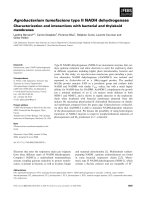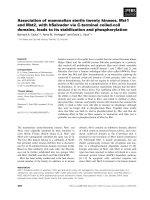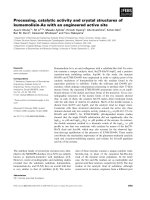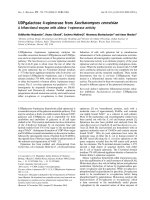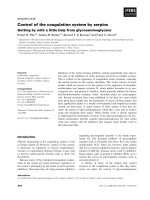Báo cáo khoa hoc:" Therapy-refractory Panton Valentine Leukocidin-positive community-acquired methicillin-sensitive Staphylococcus aureus sepsis with progressive metastatic soft tissue infection: a case report" pot
Bạn đang xem bản rút gọn của tài liệu. Xem và tải ngay bản đầy đủ của tài liệu tại đây (528.59 KB, 6 trang )
BioMed Central
Page 1 of 6
(page number not for citation purposes)
Journal of Medical Case Reports
Open Access
Case report
Therapy-refractory Panton Valentine Leukocidin-positive
community-acquired methicillin-sensitive Staphylococcus aureus
sepsis with progressive metastatic soft tissue infection: a case
report
Joerg C Schefold*
1
, Fabrizio Esposito
1
, Christian Storm
1
, Dagmar Heuck
2
,
Anne Krüger
1
, Achim Jörres
1
, Wolfgang Witte
2
and Dietrich Hasper
1
Address:
1
Department of Nephrology and Medical Intensive Care, Charité University Medicine, Campus Virchow Clinic, Berlin, Germany and
2
Robert Koch Institut, National Staphylococcal Reference Centre, Wernigerode Branch, Wernigerode, Germany
Email: Joerg C Schefold* - ; Fabrizio Esposito - ; Christian Storm - ;
Dagmar Heuck - ; Anne Krüger - ; Achim Jörres - ;
Wolfgang Witte - ; Dietrich Hasper -
* Corresponding author
Abstract
We report a case of fulminant multiple organ failure including the Acute Respiratory Distress Syndrome
(ARDS), haemodynamic, and renal failure due to community-acquired methicillin-sensitive Panton
Valentine Leukocidin (PVL) positive spa-type 284 (ST121) Staphylococcus aureus septic shock. The
patient's first clinical symptom was necrotizing pneumonia. Despite organism-sensitive triple
antibiotic therapy with linezolid, imipenem and clindamycin from the first day of treatment,
progressive abscess formation in multiple skeletal muscles was observed. As a result, repeated
surgical interventions became necessary. Due to progressive soft tissue infection, the anti-microbial
therapy was changed to a combination of clindamycin and daptomycin. Continued surgical and
antimicrobial therapy finally led to a stabilisation of the patients' condition. The clinical course of
our patient underlines the existence of a "PVL-syndrome" which is independent of in vitro
Staphylococcus aureus susceptibility. The PVL-syndrome should not only be considered in patients
with soft tissue or bone infection, but also in patients with pneumonia. Such a condition, which may
easily be mistaken for uncomplicated pneumonia, should be treated early, aggressively and over a
long period of time in order to avoid relapsing infection.
Introduction
Panton Valentine Leukocidin (PVL) positive staphylococcal
infection typically presents as life-threateninginfection of
soft-tissues and bones [1,2]. PVL-positive staphylococcal
infection may also lead to necrotizing pneumonia, a con-
dition which can even be observed before the onset of
soft-tissue or bone infection [3,4]. The underlying molec-
ular mechanisms in regard to the progression of PVL-pos-
itive staphylococcal necrotizing pneumonia and respective
methods of bacterial invasion have recently been eluci-
dated [5,6]. The genes encoding the exotoxin PVL are typ-
ically present in community-acquired methicillin-
sensitive S. aureus (CA-MSSA) [3], with about 2–5% of
PVL-positive MSSA strains. Nevertheless, this varies mark-
Published: 3 December 2007
Journal of Medical Case Reports 2007, 1:165 doi:10.1186/1752-1947-1-165
Received: 22 September 2007
Accepted: 3 December 2007
This article is available from: />© 2007 Schefold et al; licensee BioMed Central Ltd.
This is an Open Access article distributed under the terms of the Creative Commons Attribution License ( />),
which permits unrestricted use, distribution, and reproduction in any medium, provided the original work is properly cited.
Journal of Medical Case Reports 2007, 1:165 />Page 2 of 6
(page number not for citation purposes)
edly in different geographic locations. However, first cases
of community-acquired methicillin-resistant S. aureus
(CA-MRSA) have been reported. Clonal spread of PVL-
positive strains and horizontal bacteriophage-dependent
PVL-gene transfer thus contribute to an emerging health
care problem [7,8]. Although the value of routine PVL
testing in staphylococcal infection is currently unclear,
both patient and household members should undergo
PVL testing in severe or recurrent S. aureus infection in
order to prevent the spreading of these strains. De-coloni-
zation of the patient and respective household members
should then be achieved [9,10].
Case Presentation
We report the case of a 51-year old previously healthy
immunocompetent Caucasian male who developed acute
illness with fever, dyspnoea and expectoration of bloody
sputum during a diving holiday in Croatia. The patient
was admitted to a local hospital where empiric antibiotic
therapy with azithromycin and ciprofloxacin for radiolog-
ically confirmed pneumonia was initiated. Before onset of
the acute illness, symptoms suggesting previous (e.g.
viral) respiratory tract infection were not observed. After 3
days, the patient was referred to our clinic via an ambu-
lance air service.
Upon initial examination, the patient presented with
severe sepsis including renal failure. Staphylococcal
necrotizing pneumonia was diagnosed based on culture
results (blood and broncho-alveolar lavage specimens),
clinical criteria, and a high-resolution CT-scan demon-
strating signs of severe pulmonary infiltration (Fig. 1, and
Chest-X-ray: Fig. 2). Extensive lung tissue necrosis was
observed. The antibiotic regimen was changed to a combi-
nation of linezolid, imipenem and clindamycin. In corre-
lation to the clinical presentation including high-grade
fever [39.2 degrees celsius], laboratory assessment showed
signs of severe inflammatory reaction (C-reactive protein
221 [mg/L], procalcitonin 12.4 [μg/L], white blood cell
count 15.3 [×10
9
/L], platelet count 182 [×10
9
/L]. Over the
ensuing days of treatment, physical examination and radi-
ological imaging revealed abscess formation surrounding
the right sternoclavicular joint. Later, progressive diffuse
furunculosis next to the left clavicle (Fig. 3) occurred.
Blood cultures and bronchoalveolar samples obtained
under triple antibiotic therapy were repeatedly tested pos-
itive for methicillin-sensitive Staphylococcus aureus
(MSSA). Because of the unusual severity of the staphylo-
coccal infection, community-acquired Panton Valentine
Leukocidin (PVL)-positive MSSA septic shock was sus-
pected [1]. This was confirmed by PCR demonstration of
the respective PVL-genes, as previously reported by us
[11]. Furthermore, the isolates were subjected to surface
protein A (spa) sequence typing [12]. All isolates investi-
gated exhibited spa-type 284 which corresponds to multi-
locus sequence type ST121. This clonal lineage has been
associated with furunculosis in the past decade in Europe
and is associated to recent outbreaks [9].
Within 6 days of triple antibiotic therapy with linezolid,
imipenem and clindamycin, the patient developed pro-
gressive respiratory and haemodynamic failure including
development of the Acute Respiratory Distress Syndrome
(ARDS) requiring mechanical ventilation (FiO
2
0.8, paO2
79 mmHg, PEEP 15 cmH
2
O, peak inspiratory pressure 33
cmH
2
O). Furthermore, vasopressor support was necessary
for a subsequent period of more than two weeks. Ongoing
abscess formation in multiple skeletal muscles (Mm.
supraspinatus, triceps, quadriceps, gluteus maximus)
required repeated surgical interventions and drainage
despite organism-sensitive antibiotic therapy from the
first treatment day (minimal inhibitory concentrations
(mg/L): oxacillin and clindamycin both ≤ 0.25, linezolid
≤ 0.5). Several transesophageal echocardiograms never
showed signs of infectious endocarditis. Assessment of an
underlying immune disorder showed normal fasting
serum blood glucose levels (before onset of severe sepsis),
normal quantitative complement levels (C3, C4), and
normal immunoglobulin (Ig) levels, including Ig-sub-
classes. Furthermore, flow assorted cell sorting (FACS)
analyses were performed. These analyses revealed the
presence of panlymphopenia during sepsis with a normal
CD4/CD8 ratio. B- and T-cell numbers were found to be
within the limits of normal after reconvalescence.
After two weeks of ongoing metastatic soft tissue infiltra-
tion under triple antibiotic therapy (linezolid, imipenem,
clindamycin), the anti-microbial therapy was changed to
a combination of daptomycin and clindamycin. Contin-
ued antimicrobial and surgical therapy finally led to a sta-
bilisation of the patients' condition. The patient was
discharged from hospital on day 40. Oral antibiotic treat-
ment with moxifloxacin was prescribed for an additional
45 days. Twelve months after discharge, the patient was
found to be symptom-free and to be able to perform rou-
tine activities of daily life. PVL testing of the patient's
household members revealed no PVL colonization of the
patient's family.
Discussion
The case presented here shows features different from
"common" PVL-positive S. aureus infection. First, previ-
ous case series have reported a high incidence of preced-
ing viral respiratory tract illness [3,6]. In our patient,
respective symptoms were not present. Furthermore, we
are unaware of any previous report indicating that pro-
gression of the disease to septic multiple organ failure
including ARDS, acute renal and haemodynamic failure
occurred under triple organism-sensitive antibiotic ther-
Journal of Medical Case Reports 2007, 1:165 />Page 3 of 6
(page number not for citation purposes)
apy with linezolid, imipenem and clindamycin. Interest-
ingly, although this may certainly have been a
coincidence, the clinical break-through seemed to be
related to a change in the anti-microbial regime. The
change to daptomycin and clindamycin was instituted as
at this point in time therapy-refractory progressive meta-
static soft tissue infection occurred despite organism-sen-
sitive triple antibiotic therapy. Although daptomycin may
be considered in cases of severe metastatic soft tissue
infections, it seems important to mention that it should
not primarily be used for the treatment of pneumonia.
This is due to the fact that daptomycin is inactived by pul-
monary surfactant [13]. The use of a protein synthesis
inhibitor, such as linezolid or clindamycin, may espe-
cially be beneficial in the setting of a toxin-mediated sta-
phylococcal infection, and clinical data at least partially
support such an approach [14].
The clinical course of our patient may give further evi-
dence that a clinical presentation that is consistent with a
"PVL-syndrome" might be most appropriate to characterise
this life-threatening condition [15]. It should be empha-
sized, however, that the clinical efficacy of the antimicro-
bial therapy may be insufficient despite favourable in vitro
High-resolution (HR-)CT-scan at admission showing signs of severe pulmonary infiltrationFigure 1
High-resolution (HR-)CT-scan at admission showing signs of severe pulmonary infiltration.
Journal of Medical Case Reports 2007, 1:165 />Page 4 of 6
(page number not for citation purposes)
Chest X-ray imaging at admissionFigure 2
Chest X-ray imaging at admission.
Journal of Medical Case Reports 2007, 1:165 />Page 5 of 6
(page number not for citation purposes)
sensitivity testing of the PVL-positive S. aureus. This may
result in major problems with the management of the dis-
ease. Contrary to recently proposed therapeutic principles
that aim at shortening the duration of antibiotic therapy
whenever possible, this condition should be treated
aggressively and over a long period of time in order to
avoid relapsing infection. The "PVL-syndrome" might cre-
ate a growing threat in the years to come – physicians
treating staphylococcal infection should be watchful and
alert.
Conclusion
In cases of therapy-refractory PVL-positive staphylococcal
soft tissue infection, a change in the combination of the
anti-microbial therapy may be considered despite favour-
able in vitro sensitivity testing of the S. aureus. Daptomycin
might be considered in such therapy-refractory cases.
Competing interest statement
The author(s) declare that they have no competing inter-
ests.
Authors' contributions
JCS, FE, and DH collected all data and drafted the manu-
script. DH and WW performed the PCR demonstration of
the respective PVL-genes and subjected the respective iso-
lates to spa-sequence typing. CS, AK, and AJ coordinated
the input of all authors and helped to draft the manu-
script. All authors read and approved the final version of
the manuscript.
Clinical presentation of progressive furunculosis next to the left sternoclavicular jointFigure 3
Clinical presentation of progressive furunculosis next to the left sternoclavicular joint.
Publish with BioMed Central and every
scientist can read your work free of charge
"BioMed Central will be the most significant development for
disseminating the results of biomedical research in our lifetime."
Sir Paul Nurse, Cancer Research UK
Your research papers will be:
available free of charge to the entire biomedical community
peer reviewed and published immediately upon acceptance
cited in PubMed and archived on PubMed Central
yours — you keep the copyright
Submit your manuscript here:
/>BioMedcentral
Journal of Medical Case Reports 2007, 1:165 />Page 6 of 6
(page number not for citation purposes)
Consent
The authors declare that they have obtained written
informed consent from the patient for publication of this
case report.
Acknowledgements
First of all, the authors wish to thank the patient for kindly providing
informed consent to the publication of the data. The authors thank all
nurses for their dedicated care. Furthermore, the authors thank N. Weich
for language editing and proof-reading of the manuscript.
References
1. Panton PN, Valentine FCO: Staphylococcal toxin. Lancet 1932,
1:506-508.
2. Moumile K, Cadilhac C, Lina G, Berche P, Glorion C, Ferroni A:
Severe osteoarticular infection associated with Panton-Val-
entine leukocidin-producing Staphylococcus aureus. Diagn
Microbiol Infect Dis 2006, 56(1):95-97.
3. Gillet Y, Issartel B, Vanhems P, Fournet JC, Lina G, Bes M, Vandenesh
F, Piemont Y, Brousse N, Floret D, Etienne J: Association between
Staphylococcus aureus strains carrying gene for Panton-Val-
entine leukocidin and highly lethal necrotizing pneumonia in
young immunocompetent patients. Lancet 2002, 359:753-759.
4. Lina G, Piemont Y, Godailt-Gamot F, Bes M, Peter MO, Gauduchon
V, Vandenesch F, Etienne J: Involvement of Panton-Valentin leu-
kocidin-producing Staphylococcus aureus in primary skin
infections and pneumonia. Clin Infect Dis 1999, 29:1128-1132.
5. Labandeira-Rey M, Couzon F, Boisset S, Brown EL, Bes M, Benito Y,
Barbu EM, Vazquez V, Hook M, Etienne J, Vandenesch F, Bowden MG:
Staphylococcus aureus Panton Valentine Leukocidin Causes
Necrotizing Pneumonia. Science 2007, 18(315):1130-1133.
6. Foster TJ: Immune evasion by staphylococci. Nat Rev Microbiol
2005, 3(12):948-958.
7. Chambers HF: Community-associated MRSA-resistance and
virulence converge. N Engl J Med 2005, 352(14):1485-1487.
8. Boyle-Vavra S, Daum RS: Community-acquired methicillin-
resistant Staphylococcus aureus: the role of Panton-Valen-
tine leukocidin. Lab Invest 2007, 87(1):3-9.
9. Wiese-Posselt M, Heuck D, Draeger A, Mielke M, Witte W, Ammon
A, Hamouda O: Successful termination of a furunculosis out-
break due to luk S-lukF positive, methicillin-sensitive Staphy-
lococcus aureus in a german village by stringent
decolonization, 2002–2005. Clin Infect Dis 2007 in press.
10. Osterlund A, Kahlmeter G, Bieber L, Runehagen A, Breider JM:
Intrafamilial spread of highly virulent staphylococcus aureus
strains carrying the gene for Panton-Valentine leukocidin.
Scand J Infect Dis 2002, 34(10):763-764.
11. Witte W, Braulke C, Cuny C, Strommenger B, Werner G, Heuck D,
Jappe U, Wendt C, Linde HJ, Harmsen D: Emergence of methicil-
lin-resistant
Staphylococcus aureus with Panton-Valentine
leukocidin genes in central Europe. Eur J Clin Microbiol Infect Dis
2005, 24(2):1-5.
12. Harmsen D, Claus H, Witte W, Rothganger J, Claus H, Turnwald D,
Vogel U: Typing of methicillin-resistant Staphylococcus aureus
in a university hospital setting by using novel software for spa
repeat determination and database management. J Clin Micro-
biol 2003, 41(12):5442-5448.
13. Silverman JA, Mortin LI, Vanpraagh AD, Li T, Alder J: Inhibition of
daptomycin by pulmonary surfactant: in vitro modeling and
clinical impact. J Infect Dis 2005, 191(12):2149-2152.
14. Micek ST: Alternatives to Vancomycin for the Treatment of
Methicillin-Resistant Staphylococcus aureus Infections. Clin
Infect Dis 2007, 45:S184-S190.
15. Swaminathan A, Massasso D, Gotis-Graham I, Gosbell I: Fulminant
methicillin-sensitive Staphylococcus aureus infection in a
healthy adolescent, highlighting 'Panton-Valentine leucoci-
din syndrome'. Intern Med J 2006, 36(11):744-747.
